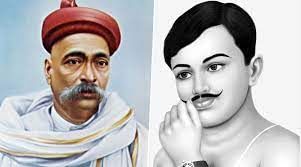UPSC Daily Current Affairs- 27th July 2023 | Current Affairs & Hindu Analysis: Daily, Weekly & Monthly PDF Download
GS-I
530 districts reported free of Manual Scavenging: Centre
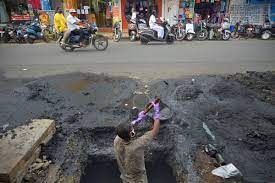
Why in News?
The Social Justice Ministry revealed that while 530 districts have reported themselves as manual scavenging-free, a significant number of districts are yet to do so.
- Despite the government’s assertion that manual scavenging-related deaths have not occurred in the last five years, fatalities during sewer and septic tank cleaning persist.
Manual Scavenging in India
- Manual scavenging is the practice of removing human excreta by hand from sewers or septic tanks.
- India banned the practice under the Prohibition of Employment as Manual Scavengers and their Rehabilitation Act, 2013 (PEMSR).
- The Act bans the use of any individual for manually cleaning, carrying, disposing of or otherwise handling in any manner, human excreta till its disposal.
- In 2013, the definition of manual scavengers was also broadened to include people employed to clean septic tanks, ditches, or railway tracks.
- The Act recognizes manual scavenging as a “dehumanizing practice,” and cites a need to “correct the historical injustice and indignity suffered by the manual scavengers.”
Reasons for its persistence
- Low Awareness and Marginalization: Manual scavenging is often carried out by marginalized sections of society who are unaware of their rights, making them vulnerable to exploitation.
- Enforcement Issues: Weak enforcement of the Act and the exploitation of unskilled laborers contribute to the persistence of manual scavenging.
- High Cost of Automation: The high cost of adopting automated cleaning methods in sewers is a deterrent for municipal authorities.
- Cheaper Availability of Unskilled Labor: Contractors resort to illegal employment of unskilled labourers who are willing to work at lower wages, perpetuating the practice.
- Caste Dynamics: The practice is reinforced by the existing caste hierarchy, with a majority of manual scavengers belonging to lower castes.
Various Policy Initiatives
- Prohibition of Employment as Manual Scavengers and their Rehabilitation (Amendment) Bill, 2020: The proposed amendment seeks to mechanize sewer cleaning, provide on-site protection, and offer compensation in case of sewer-related deaths.
- Prohibition of Employment as Manual Scavengers and their Rehabilitation Act, 2013: This Act goes beyond dry latrine prohibitions and outlaws all forms of manual excrement cleaning in insanitary latrines, open drains, or pits.
- Rashtriya Garima Abhiyan: The “Maila Mukti Yatra,” initiated in 2012, aims to eradicate manual scavenging nationwide, starting from Bhopal.
- Prevention of Atrocities Act: This Act serves as protection for sanitation workers, as a significant number of manual scavengers belong to the Scheduled Caste.
- Compensation: The PEMSR Act and the Supreme Court’s decision in the Safai Karamchari Andolan vs. Union of India case mandate compensation of Rs 10 lakh for victims’ families.
- National Commission for Safai Karamcharis (NCSK): Investigating the conditions of waste collectors in India, the NCSK provides recommendations to the government.
- Proper Distinction: The Ministry now recognizes the difference between sanitation work and manual scavenging.
- Enumeration of Sanitization Workers: The enumeration of sanitation workers will be conducted in 500 AMRUT cities as part of the National Action Plan for Mechanised Sanitation Ecosystem (NAMASTE).
- NAMASTE Scheme: The NAMASTE scheme aims to eliminate unsafe sewer and septic tank cleaning practices, enhancing the safety and dignity of sanitation workers.
States and UTs with Pending Declaration of Manual Scavenging-Free Districts
- Concerning Data: Jammu and Kashmir, Manipur, Telangana, Andhra Pradesh, West Bengal, and Jharkhand are among the States and UTs with the highest number of districts yet to declare themselves as manual scavenging-free.
- Disparity among States: While States like Bihar, Rajasthan, and Tamil Nadu have achieved 100% declaration of manual scavenging-free districts, several other States and UTs have reported only 15% to 20% of districts as free from the practice.
Way forward
- Regular surveys and social audits must be conducted against the involvement of manual scavengers by public and local authorities.
- There must be proper identification and capacity building of manual scavengers for alternate sources of livelihood.
- Creating awareness about the legal protection of manual scavengers is necessary.
Source: The Hindu
Gulf Stream
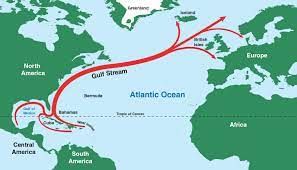
Why in News?
A recent study suggests the Gulf Stream system could collapse as soon as 2025.
About Gulf Stream:
- What is it? The Gulf Stream is a swift and warm ocean current that flows along the eastern coast of North America and crosses the Atlantic Ocean towards Europe.
- Key characteristics:
- Location: It originates in the Gulf of Mexico and is primarily formed by the convergence of warm waters from the Caribbean Sea and the Gulf of Mexico. It then travels northward along the eastern coast of the United States.
- Direction: It follows a north-eastward path across the western North Atlantic Ocean.
- Warmth: The current carries warm water from the tropics (around 25 to 28°C or 77 to 82°F) to higher latitudes.
- Width and Speed: The Gulf Stream is several hundred kilometres wide and can flow at an average speed of about 2.5 meters per second. However, its speed can vary depending on the location and other factors.
- Depth: The current is also very deep, extending to depths of up to 1,000 meters.
- Importance and Impact:
- Climate Regulation: It moderates the temperatures along the eastern coast of North America, keeping the coastal areas warmer in winter and cooler in summer compared to inland regions at the same latitudes. Since the Gulf Stream also extends toward Europe, it warms Western European countries as well.
- Weather Patterns: The warm and moist air above the Gulf Stream can lead to the formation of low-pressure systems, which may develop into storms or hurricanes. It can also contribute to the formation of fog in certain areas.
- Maritime Navigation: The Gulf Stream has been a crucial factor in maritime navigation for centuries. It provides a fast and efficient route for ships travelling between North America and Europe, as it aids in faster travel times due to its speed.
- Ocean Circulation: The Gulf Stream is an essential part of the larger oceanic circulation system known as the Atlantic Meridional Overturning Circulation (AMOC). The AMOC plays a vital role in redistributing heat around the Earth and regulating global climate patterns.
Key facts about Atlantic Meridional Overturning Circulation (AMOC):
- It is a large system of ocean currents operating In the Atlantic, which circulates the waters between the north and the south.
- It is characterized by a northward flow of warm, salty water in the upper layers of the Atlantic, and a southward flow of colder, deep waters that are part of the thermohaline circulation.
- How it operates:
- As warm water flows northwards in the Atlantic, it cools, while evaporation increases its salt content.
- Low temperature and a high salt content raise the density of the water, causing it to sink deep into the ocean.
- The cold, dense water deep below slowly spreads southward. Eventually, it gets pulled back to the surface and warms again, and the circulation is complete.
- Significance: AMOC ensures the oceans are continually mixed, and heat and energy are distributed around Earth.
What is an Ocean Current?
- An ocean current is a continuous, directed flow of seawater within the Earth's oceans.
- These currents are like rivers within the ocean, moving large volumes of water in specific patterns and directions.
- They are a crucial component of the Earth's climate system and play a vital role in regulating global climate, distributing heat around the planet, and influencing weather patterns.
- Ocean currents can be formed by various factors, including wind, temperature, salinity (salt content), and the Earth's rotation.
Source: PIB
Bal Gangadhar Tilak and Chandra Shekhar Azad
Why in News?
Prime Minister Narendra Modi paid his tributes to Bal Gangadhar Tilak and Chandra Shekhar Azad on their birth anniversaries on July 23.
Background:-
- Saluting Indian nationalist and freedom fighter Bal Gangadhar Tilak, Prime Minister Modi said in a tweet, Lokmanya Tilak shook the foundation of British rule by demanding complete Independence.
- While remembering revolutionary freedom fighter Chand Shekhar Azad fondly, the Prime Minister called him a gallant son of ‘Bharat Mata’ and a remarkable man.
About Bal Gangadhar Tilak:-
- Birth: July 23, 1856.
- Birthplace: Ratnagiri (now in Maharashtra state), India.
- Death: August 1, 1920, in Mumbai.
- He was a scholar, mathematician, philosopher, and ardent nationalist who helped lay the foundation for India’s independence by building his own defiance of British rule into a national movement.
- He was also known as Lokmanya Tilak.
- His famous declaration “Swaraj is my birthright, and I shall have it” served as an inspiration for future revolutionaries during India’s struggle for freedom.
- The British Government termed him the “Father of Indian Unrest”. (Sedition Law)
Important Institutions Started by Tilak:-
- Deccan Education Society (1884): He was the founder of the Deccan Education Society along with his associate Gopal Ganesh Agarkar and others.
- Fergusson College (1885): He was one of the founders of the Fergusson College in Pune.
The ideology of Tilak:-
- He vocalized his strong opposition to the moderate views of the Indian National Congress (INC) on self-rule.
- He maintained that simple constitutional agitation in itself was futile against the British.
- He wanted an armed revolt against the British.
- Following the partition of Bengal by Lord Curzon, Tilak wholeheartedly supported the Swadeshi (Indigenous) movement and the Boycott of British goods.
- Due to this fundamental difference in outlook, Tilak and his supporters came to be known as the extremist wing of INC.
- He was a great reformer and throughout his life, he advocated the cause of women’s education and women’s empowerment.
- Tilak proposed Grand celebrations on ‘Ganesh Chaturthi’ and ‘Shivaji Jayanti’.
- He envisioned these celebrations inciting a sense of unity and inspiring nationalist sentiment among Indians.
Political ventures of Tilak:-
- 1890: He joined the Indian National Congress (INC).
- Tilak protested against the oppressive nature of the British efforts and wrote provocative articles on it in his newspapers on the epidemic of the Plague in Pune and adjacent regions.
- His article inspired the Chapekar brothers and they carried out the assassination of Commissioner Rand and Lt. Ayerst on June 22,
- Because of this, Tilak was imprisoned for 18 months on Sedition charges for inciting murder.
- Indian Home Rule League (1914): He founded the Indian Home Rule League.
- Lucknow Pact (1916): he concluded the Lucknow Pact with Mohammed Ali Jinnah, which provided for Hindu-Muslim unity in the nationalist struggle.
Newspapers by Tilak:-
- Weeklies: Kesari (Marathi) and Mahratta (English)
Books by Tilak:-
- Gita Rhasya
- Arctic Home of the Vedas.
About Chandra Shekhar Azad:-
- Birth: 23rd July 1906.
- Birth Place: Alirajpur district of Madhya Pradesh.
- Death: On February 27, 1931.
- He died at Azad Park in Allahabad on 27th February 1931.
- Chandrashekhar Azad was a great Indian freedom fighter.
- He was the mentor of Bhagat Singh.
- He is considered one of the greatest revolutionaries that India has produced.
Political ventures of Chandrashekhar Azad:-
- 1921: when Gandhiji launched the Non-Cooperation Movement, Chandra Shekhar, then a 15-year-old student, joined.
- He was arrested.
- On being presented before a magistrate, he gave his name as “Azad” (The Free), his father’s name as “Swatantrata” (Independence) and his residence as “Jail”.
- From that day, he came to be known as Chandra Shekhar Azad among the people.
- 1925: Involved in the Kakori train Robbery.
- 1926: he was involved in an attempt to blow up the Viceroy of India’s train.
- 1928: he was involved in the shooting of J. P. Saunders at Lahore to avenge the killing of Lala Lajpat Rai.
Organizations by Chandrashekhar Azad:-
- Hindustan Republican Association: After the suspension of the non-cooperation movement in 1922 by Gandhi, Azad joined Hindustan Republican Association (HRA).
Source: AIR
GS-II
Adjournment motion
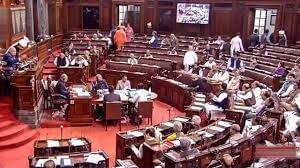
Why in News?
Recently, an adjournment motion was moved in the Lok Sabha, citing the need for urgent discussions on the ethnic violence in Manipur.
Background:-
- Opposition parties demanded a discussion on the alleged sexual assault of at least two women in Manipur, amid the ongoing ethnic violence in the state.
About the adjournment motion:-
- An adjournment motion is introduced in the Parliament to draw the attention of the House to a definite matter of urgent public importance.
- It needs the support of 50 members to be admitted.
- It is done after obtaining the Speaker’s consent.
- It is introduced only in the Lok Sabha.
- The Rajya Sabha Rule Book does not provide for an adjournment motion.
- It is regarded as an extraordinary device as it interrupts the normal business of the House.
- Notice of an adjournment motion is required to be given before 10 am on the day on which the motion is proposed.
- If the adjournment motion is accepted, the House adjourns after voting.
- The adoption of an adjournment motion is seen as a censure of the government.
- However, there is no compulsion on the government to resign.
Restrictions for moving an adjournment motion:-
- It must raise a matter which is definite, factual, urgent and of public importance.
- It must not cover more than one matter.
- It must be restricted to a specific matter of recent occurrence.
- It must not raise a question of privilege.
- It must not revive discussion on a matter that has been discussed in the same session.
- It must not deal with any matter that is under adjudication of court.
- It must not raise any question that can be raised on a distinct motion.
- The discussion on this motion should last for not less than two hours and thirty minutes.
Source: Indian Express
RTI and Political Parties: The Accountability Debate
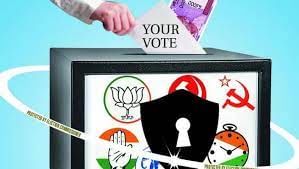
Why in News?
Chief Justice of India acknowledged the concerns raised by political parties regarding the potential disclosure of internal decisions under the Right to Information (RTI) Act.
- The case before the three-judge Bench seeks to determine whether national and regional political parties should be considered “public authorities” under the RTI Act.
- The court will delve into the matter further to strike a balance between transparency and the confidentiality of parties’ internal functions.
Facts for Prelims: Right to Information (RTI) Act
| Enactment | June 15, 2005 |
| Objective | Promote transparency and accountability |
| Applicability | All public authorities at central, state, local levels |
| Scope | Access to information on matters of public interest, government policies, budgets, etc. |
| RTI Application | Filed in writing with the concerned public authority |
| Response Time | Within 30 days (48 hours for life or liberty issues) |
| Exemptions | Some information exempted to protect national security, privacy, etc. Judiciary |
| Fees | Nominal fee varies based on state and information requested |
| First Appellate Authority | Filed if dissatisfied with the response |
| Second Appeal | Filed with the relevant Information Commission |
| Whistleblower Protection | Safeguards against victimization for exposing corruption |
| Impact | Promotes transparency, accountability, and good governance |
RTI Act and Political Parties
- Petitions Seeking Declaration: A batch of petitions has been filed, urging that political parties should be classified as “public authorities” under the RTI Act. The Congress, BJP, and other parties are respondents in this case.
- Concerns Raised: The Communist Party supports financial transparency but objects to revealing confidential information, such as candidate selection processes and internal discussions.
- Judicial Observation: CJI acknowledged the concerns, indicating that parties may have a point in not disclosing internal candidate selection processes.
Arguments Presented
- Benefits and Governance Role: Petitioners argue that political parties receive considerable benefits from the government, including bungalows, and play a role in governance through legislator control.
- CIC’s Ruling: The Central Information Commission (CIC) had previously declared political parties as public authorities in 2013 and 2015.
- Parties’ Response: Political parties have expressed reservations, stating that RTI disclosure may intrude on confidential discussions, affect their stance towards the government, and hinder their ability to organize protests against government policies.
- Union Government’s Stand: The government opposes the petitions, contending that parties’ internal functioning and financial information should not be compelled under the RTI Act, as this could be misused by political rivals.
CIC’s Interpretation
- Liberal Interpretation of RTI Act: The CIC’s interpretation of Section 2(h) of the RTI Act, classifying political parties as public authorities, has been disputed.
- Political Parties Not Government Bodies: The Centre argues that political parties are not government bodies established by the Constitution or any parliamentary law.
- Existing Transparency Provisions: The Income Tax Act and the Representation of the People Act already require necessary transparency regarding financial aspects of political parties.
Conclusion
- The case raises essential questions about transparency versus confidentiality in their internal operations of a political party.
- Striking a balance between citizens’ right to information and parties’ right to maintain confidentiality will be crucial in the court’s deliberation.
- The judgment could set a precedent for how political parties are held accountable to the public while safeguarding their internal processes.
Source: The Hindu
GS-III
Mhadei Wildlife Sanctuary
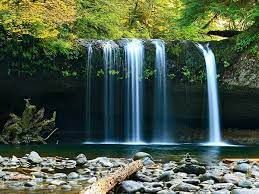
Why in News?
The Goa bench of the Bombay High Court has directed the Goa government to notify the Mhadei Wildlife Sanctuary as a tiger reserve.
About Mhadei Wildlife Sanctuary:-
- Location: in the northeast of Goa, in the taluka of Sattari.
- Its official declaration as a wildlife preserve came in 1999.
- The Mhadei River, known downstream as the Mandovi River, the lifeline of the state of Goa, originates in Karnataka, passes through the Mhadei Wildlife Sanctuary and meets the Arabian Sea at Panaji in Goa.
- The whole sanctuary acts as a catchment for the river.
- Prominent Waterfalls: Vazra Sakla Falls and the Virdi Falls.
- The cliff face near the Vazra Falls is notable for being the nesting grounds of the critically endangered Long-billed vultures.
- It has been declared an International Bird Area because of the presence of the Nilgiri wood pigeon, Malabar parakeet, Malabar grey hornbill, Grey-headed Bulbul, Rufous babbler, White-bellied blue-flycatcher and Crimson-backed sunbird.
- The three highest peaks in Goa are situated in the hill ranges of the sanctuary. They are Sonsogod (1027 mts), Talavche Sada (812 mts) and Vageri (725 mts).
- Flora:-
- The area of the sanctuary is thickly forested with moist deciduous vegetation and some evergreen species
- The sanctuary is particularly well known for its sacred groves that protect rare and indigenous trees.
- Fauna:-
- Commonly seen animals: Indian gaur, Barking deer, Sambar deer, Asian palm civet, small Indian civet, Wild boar, Indian hare, Ruddy mongoose, Black-faced langur and Bonnet macaque.
- Rarely seen: Black Panther, Sloth bear, Leopard, Tiger, Dhole, Jungle cat, Mouse deer, Giant squirrel, Flying squirrel, Indian pangolin and the Slender loris.
Source: Indian Express
Conjunctivitis
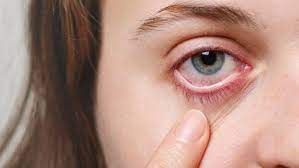
Why in News?
Amid heavy rainfall in Delhi and nearby areas over the past few weeks, multiple cases of conjunctivitis are being reported in the National Capital Region.
About Conjunctivitis:
- Conjunctivitis, commonly known as Pink Eye, is an infection or inflammation of the transparent membrane that covers the eyelid and eyeball. This membrane is called the conjunctiva.
- Why do eyes appear Pink?
- When small blood vessels in the conjunctiva become swollen and irritated, they're more visible.
- This is what causes the whites of the eyes to appear reddish or pink.
- Causative Agent:
- It can be caused by viruses, bacteria or by allergies.
- Both bacterial and viral conjunctivitis are highly contagious, while allergic conjunctivitis is not.
- Transmission:
- It usually occurs through direct or indirect contact.
- Direct transmission happens through droplets from the cough or sneeze of an infected person or through hand-to-eye contact.
- Indirectly, it can spread via shared personal items like towels, makeup, pillows or contact lenses.
- Signs and symptoms:
- Most common signs are redness, swelling and itching in the eyes.
- The eyes can also feel watery during the start of the flu.
- Treatment:
- For the treatment of conjunctivitis, one needs to use a combination of medicines.
- One of the most useful treatments is using artificial tears or even any lubricating eye drops; these can help the infected person to maintain moisture.
- A warm or cold compress will also help in giving relief from inflammation and swelling.
Source: Mint
A big step in reducing the risk of disasters
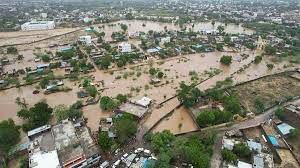
Why in News?
The world needs to do more to prevent the risk of losses from all disasters, whether they are weather-related, earthquakes, or biological ones like COVID-19.
About a Disaster:
- A disaster refers to a significant disturbance in the normal functioning of a community, leading to human, material, economic, and environmental damages that surpass the community’s capacity to manage.
- It results from the combination of hazards, conditions of vulnerability and insufficient capacity or measures to reduce the potential negative consequences of risk.
Classification of Disasters
On the Basis of Source
- Natural Disasters: They are caused by natural phenomena (meteorological, geological or even biological origin).
- Examples of natural disasters are cyclones, tsunamis, earthquakes and volcanic eruptions, which are exclusively of natural origin.
- Landslides, floods, drought, fires are socio-natural disasters since their causes are both natural and manmade.
- Anthropogenic Disasters: They occur due to human intervention or negligence.
- These are associated with industries or energy generation facilities and include explosions, leakage of toxic waste, pollution, dam failure, wars or civil strife etc.
On the Basis of Duration
- Rapid Onset Disasters: They are characterised by the sudden and acute intensity of the impact during a short period.
- Earthquakes, cyclones, floods, tsunamis would fall under the category of rapid onset disasters.
- Slow Onset Disasters: Also termed as ‘Creeping Emergencies’, can be predicted much further in advance and unfold over months or even years.
- Climate change (global warming), desertification, soil degradation, and droughts, would fall under the category of slow onset disasters.
Disasters around the world
- Disasters around the world are claiming more and more lives. The consequences of climate change are already on our doorstep.
- Recently, three continents were gripped by heat waves.
- Massive forest fires have ravaged parts of Greece and Canada.
- Two weeks ago, the river Yamuna breached the highest flood level, recorded 45 years ago, and inundated parts of Delhi.
Sendai Framework 2015-2030
- The Sendai Framework works hand in hand with the other 2030 Agenda agreements, including the Paris Agreement on Climate Change, The Addis Ababa Action Agenda on Financing for Development, the New Urban Agenda, and ultimately the SDG.
- It was endorsed by the UN General Assembly following the 2015 Third UN World Conference on Disaster Risk Reduction (WCDRR).
- It advocates for the substantial reduction of disaster risk and losses in lives, livelihoods, and health and in the economic, physical, social, cultural, and environmental assets of persons, businesses, communities, and countries.
- State has the primary role to reduce disaster risk but that responsibility should be shared with other stakeholders including local government, the private sector, and other stakeholders.
Challenges to Disaster Risk Reduction Mechanism
- The lack of competent financial risk management and insurance has provided a fertile breeding ground for these risks to proliferate and intensify.
- There is also a scarcity of investment in a development-oriented approach that unites all parties into a transparent framework of action at the national level.
- Significant difficulty in collecting and analysing data on hazards and exposures.
- The lack of technical and institutional capacity for risk assessment and modelling.
- Achieving comprehensive coverage of disaster risks.
Impacts of Disaster:
- Loss of Economy and Infrastructure: Disaster results in huge economic loss due to destruction of property, human settlements etc.
- Loss of Biodiversity: Disaster can change the natural environment, loss of habitat to many plants and animals and cause ecological stress that can result in biodiversity loss.
- Scarcity of basic necessities: Post- disasters, food, water and other natural resources become scarce resulting in food and water scarcity.
- Increase in Inequality: The disaster results in displacement of people and displaced populations often face several challenges in new settlements, in this process, they become poorer.
- Psychological Impact: Disaster increases the level of vulnerability and affects psychologically too.
Disaster Management in India
- National Disaster Management Authority (NDMA)
- National Disaster Response Force (NDRF)
Initiatives by India
Coalition for Disaster Resilient Infrastructure (CDRI):
- Coalition for Disaster Resilient Infrastructure (CDRI) was first proposed by India during the 2016 Asian Ministerial Conference on Disaster Risk Reduction held in New Delhi.
- India is taking the lead and offering the expertise of Disaster Resilient Infrastructure (DRI) to its friendly countries.
Humanitarian Aid and Disaster Relief (HADR) operations:
- Indian defence forces, under the aegis of Headquarters Integrated Defence Staff (HQ IDS) have been carrying out HADR operations within the country as well as outside the country to deepen coordination with its neighbours and friendly countries with a focus on sharing expertise and building capabilities.
India’s initiative at G20 – Disaster Risk Reduction Working Group:
- India has established the first G20 Disaster Risk Reduction Working Group.
- Countries that make up the G20 hold around 85% of the global GDP and about two-thirds of the world population.
- As human vulnerability to disasters is strongly linked to economic decisions, the G20 is in a unique position to chart a new path of disaster risk-informed decision-making.
Way Forward:
- Early Warning System: There is a need to work on receiving early warnings as much as possible, which helps in mitigating the disasters.
- High Budget Allocation: High allocation of budget and resources are necessary to take mitigating actions and after-effect actions.
- Resilient Infrastructure: It should be focused on to prevent extreme situations.
- Transparency: Transparency mechanisms should include transparency boards, clearly mentioning the cost, quality and quantity of relief items, social audits and citizens’ reports.
- Awareness and Knowledge: Awareness is the best practice that can prevent and reduce the impact of disasters. Traditional and modern knowledge both should be spread and implied to mitigate the impacts of disasters.
- Example: The tribal communities in India adopt low-cost traditional technologies that help them mitigate the impact of natural disasters like drought.
Source: The Hindu
|
38 videos|5288 docs|1117 tests
|


